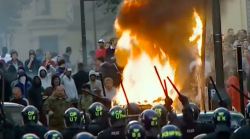The question of how normative form changes during a riot, and thus how collective behaviour spreads to different targets and locations, has been neglected in previous research, despite its theoretical and practical importance. This project begins to address this limitation through a detailed analysis of the rioting in the London Borough of Haringey in 2011. A triangulated analysis of multiple sources of data (including police reports, media accounts and videos) finds a pattern of behaviour shifting from collective attacks on police targets to looting. A thematic analysis of 41 interview accounts with participants gathered shortly after the events suggests that a shared anti-police identity allowed local postcode rivalries to be overcome, forming the basis of empowered action not only against the police but to address more long-standing grievances and desires. It is argued that collective psychological empowerment operated in a ‘positive feedback loop’, whereby one form of collective self-objectification (and perceived inability of police to respond) formed the basis of further action. This analysis of the development of new targets in an empowered crowd both confirms and extends the elaborated social identity model as an explanation for conflictual intergroup dynamics.
how collective behaviour spreads to different targets and locations, has been neglected in previous research, despite its theoretical and practical importance. This project begins to address this limitation through a detailed analysis of the rioting in the London Borough of Haringey in 2011. A triangulated analysis of multiple sources of data (including police reports, media accounts and videos) finds a pattern of behaviour shifting from collective attacks on police targets to looting. A thematic analysis of 41 interview accounts with participants gathered shortly after the events suggests that a shared anti-police identity allowed local postcode rivalries to be overcome, forming the basis of empowered action not only against the police but to address more long-standing grievances and desires. It is argued that collective psychological empowerment operated in a ‘positive feedback loop’, whereby one form of collective self-objectification (and perceived inability of police to respond) formed the basis of further action. This analysis of the development of new targets in an empowered crowd both confirms and extends the elaborated social identity model as an explanation for conflictual intergroup dynamics.
The full triangulated account for Haringey can be found here.

